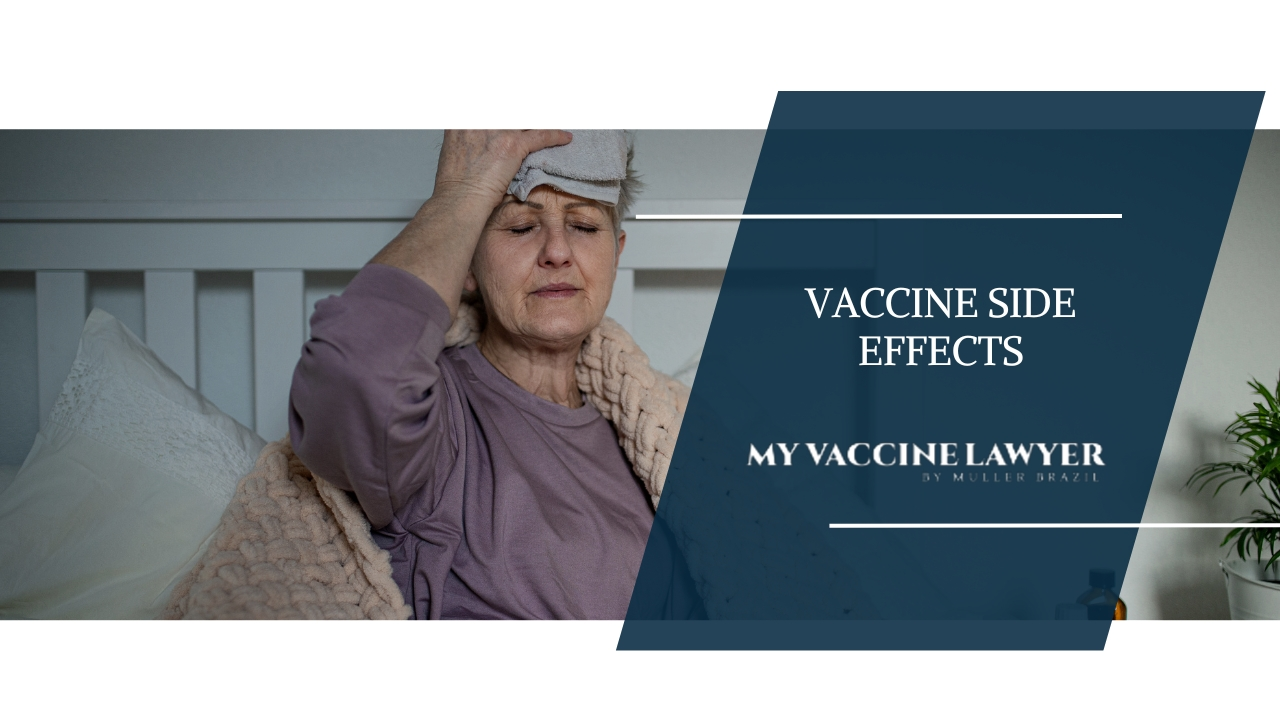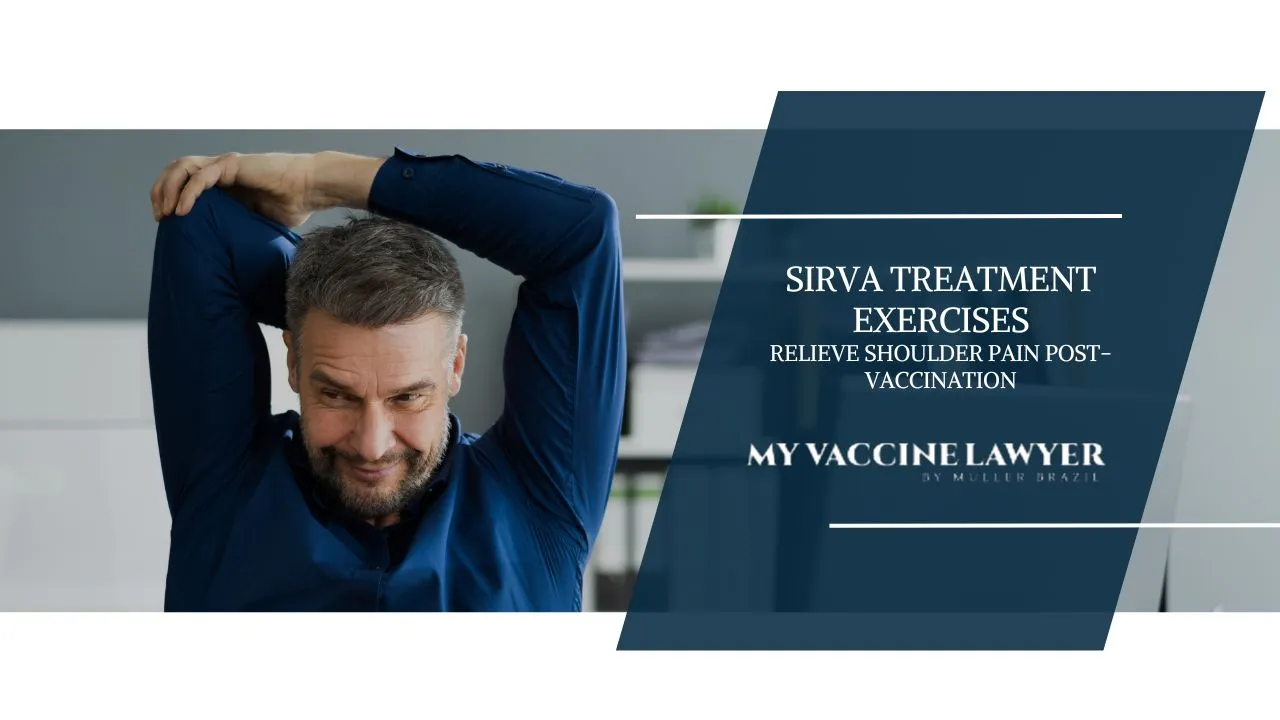Pneumonia Shot Pain: How Long It Lasts & When to Worry
Getting a vaccine is a routine part of staying healthy, but that doesn’t mean it’s always comfortable. If you've recently received a pneumonia shot,...
7 min read
Vaccine Injury Law Resources / Treatment / SIRVA Exercises: Easing Shoulder Pain After Vaccination
 Paul Brazil
:
Nov 16, 2023 12:00:00 PM
Paul Brazil
:
Nov 16, 2023 12:00:00 PM
If you experience shoulder pain after a vaccination, you might have a Shoulder Injury Related to Vaccine Administration (SIRVA). Exercises like the Cross-Body Stretch, Pendulum Exercise, and Wall Walk Exercise can help reduce pain and improve mobility. Practicing safe exercise techniques, warming up properly, and consulting healthcare professionals are very important. If symptoms persist or cause complications, you may need help and legal counsel for potential compensation.
Shoulder Injury Related to Vaccine Administration (SIRVA) is caused by incorrect vaccine injection, often associated with the seasonal flu shot and tetanus vaccine. Due to similar symptoms, SIRVA can sometimes be mistaken for frozen shoulder. It is considered uncommon and frequently not reported, affecting many people. This vaccine-related shoulder injury is an important issue to be aware of during vaccine administration.
The causes of SIRVA are directly linked to improper injection techniques, inappropriate needle length, or incorrect injection sites. Using an excessively long needle increases the risk of the injection affecting nerves, blood vessels, or skeletal structures, leading to inflammation and shoulder pain, often mistaken for shoulder bursitis symptoms.
Incorrect vaccine placement into the shoulder joint can also result in shoulder injury or pain, sometimes even leading to shoulder injuries. Other minor causes not commonly known include:
Patients with SIRVA may experience shoulder pain, reduced range of motion, weakness, and inflammation. Severe shoulder pain and reduced mobility are the initial indications of SIRVA.
SIRVA can decrease the range of motion in the shoulder, impacting all planes of motion. Individuals with SIRVA may also exhibit weakness in the affected shoulder, which can cause discomfort around the shoulder blades.
Having gained a better understanding of SIRVA, we will now explore some exercises that aid in relieving shoulder pain associated with this condition. These exercises include:
Incorporating these exercises into your daily routine will increase your shoulder's mobility and diminish pain.
The Cross-Body Stretch exercise involves crossing the affected arm across the chest and gently pulling it towards the contralateral shoulder. Cross-body stretching helps improve shoulder flexibility and reduces pain associated with SIRVA.
To perform the Cross-Body Stretch:
For the Pendulum Exercise specific to SIRVA, you'll need to:
This exercise promotes shoulder mobility and pain relief. The Pendulum Exercise should be executed for approximately 5 minutes, 3 times daily.
The Wall Walk Exercise involves placing your pointer and middle finger on a wall and slowly progressing them up the wall until the maximum reach is achieved. This exercise improves shoulder range of motion and strength.
To successfully execute the Wall Walk exercise, focusing on using your fingers rather than your arm muscles is important.
The Towel Stretch exercise involves holding a bath towel horizontally behind the back, with both hands grasping the ends. Then, using the uninjured arm, the affected arm should be pulled up to stretch it.
The Towel Stretch has been shown to increase shoulder flexibility and reduce pain associated with SIRVA. To help with SIRVA, it is recommended that you perform the towel stretch 10 to 20 times a day, each for approximately 30 seconds.
The Armpit Stretch exercise involves:
The Armpit Stretch increases shoulder mobility and reduces discomfort.
Certain key tips should be followed to maximize the benefits of your SIRVA exercise routine. Warming up before exercising, progressing gradually, and consulting with healthcare professionals will help keep your exercise routine safe and effective.
It's important to warm up before exercising to prevent injury and increase your range of motion.
The importance of warming up and cooling down cannot be overstated in any exercise routine, particularly for those recuperating from SIRVA. Warming up increases muscle elasticity, improves flexibility, and reduces the risk of injury, while cooling down helps your body return to its normal state, reducing the risk of muscle soreness and stiffness.
Some effective warm-up exercises for SIRVA patients include straight arm circles, overhead shoulder rotation lasso, and cross-body shoulder swings. Cooling down is achieved by performing gentle stretches like the pendulum, up-the-back, and light stretch.
For SIRVA patients, a safe and effective exercise routine requires gradual progression. By starting with gentle exercises and gradually increasing the intensity and range of motion, you avoid putting excessive strain on your shoulder joint and tissues, allowing for proper healing and improved mobility.
A gradual progression in your SIRVA exercise routine will help you achieve the best possible results without causing further injury or discomfort.
When starting an exercise routine for SIRVA treatment, consulting with healthcare professionals is important. Healthcare professionals provide guidance on specific exercises, such as:
These exercises help relieve shoulder pain and improve mobility.
Healthcare professionals also monitor your progress through regular follow-up appointments and assessments, evaluating your range of motion, strength, and pain levels to guarantee that you are on the right track toward recovery.
Treatment for SIRVA includes conservative measures such as rest and medication, physical therapy, and, in rare cases, surgery. The most common non-surgical treatments for SIRVA include pain relief medications and steroid injections. Pain relief medications aim to alleviate pain, while steroid injections reduce inflammation.
Although SIRVA is considered uncommon and frequently unreported, treatment options are available for those who experience this condition. The treatment procedure for SIRVA may include:
The initial step in the treatment protocol for SIRVA at Maple Healthcare is chiropractic adjustment targeted at the shoulder.
For those who prefer the conservative approach to discomfort and pain in the shoulder, conservative treatments for SIRVA include:
Steroid injections have demonstrated efficacy in the conservative treatment of SIRVA, reducing inflammation and alleviating symptoms. The procedure for administering steroid injections for SIRVA treatment includes injecting corticosteroids directly into the affected shoulder joint to reduce inflammation and relieve SIRVA-related pain.
Rest is important in the conservative treatment of SIRVA, reducing inflammation and promoting healing in the affected area.
Physical therapy for SIRVA may include the following exercises and stretches:
These exercises are designed to relieve pain for those who have experienced shoulder pain, aiming to improve shoulder function and reduce discomfort.
Physical therapy effectively reduces pain caused by SIRVA by focusing on stretching, strengthening, and increasing the range of motion in the shoulder. Although the success rate of physical therapy for SIRVA treatment varies, most patients experience improved shoulder pain and symptom relief.
Surgical intervention for SIRVA is uncommon and is usually only considered for extreme cases that have not responded to conservative treatments. Repair or reconstruction of damaged tendons, ligaments, or other structures in the shoulder are typically used to treat SIRVA.
Surgery may lead to rotator cuff injuries, bursitis, adhesive capsulitis, shoulder pain, weakness, and decreased range of motion.
If you believe you may have SIRVA, securing professional help early is key to guaranteeing appropriate treatment and recovery. Be sure to consult a healthcare professional if your symptoms worsen, remain unchanged, or if you suspect a vaccine-related injury.
Healthcare professionals provide a thorough examination, imaging tests, and a personalized treatment plan to help you recover from SIRVA.
Take Control of Your Injury Today
If you experience persisting or intensifying pain, reduced range of motion, or weakness, it's time to consult a doctor. These symptoms could indicate a more serious injury or nerve damage, and it's important to get a proper diagnosis and treatment plan to make sure the best possible outcome for your recovery.
During the evaluation and treatment process for SIRVA, you can expect a thorough examination, including imaging tests such as MRI and ultrasound.
Your healthcare professional will work with you to develop a personalized treatment plan, including exercises and stretches tailored to your specific needs and restrictions.
Should you suspect a vaccine-related injury and consider yourself eligible for compensation through the National Vaccine Injury Compensation Program (VICP), seeking legal counsel becomes imperative.
The VICP is a specialized court system designed to adjudicate claims of vaccine injury in the United States, providing compensation to individuals who have been found to have sustained injury due to certain vaccines.
The treatment for SIRVA ranges from conservative measures like rest and medication to physical therapy and, in rare cases, surgical intervention. Various exercises, including the Cross-Body Stretch, Pendulum Exercise, Wall Walk Exercise, Towel Stretch, and Armpit Stretch, have been proven effective in relieving the associated pain and improving range of motion.
Following safe exercise practices, such as warming up and cooling down, gradual progression and consultation with healthcare professionals will make a big difference. If symptoms persist or worsen, seeking professional help promptly for proper diagnosis and treatment is important. Surgical intervention may be considered for severe cases that do not respond to conservative treatments.
In case of a suspected vaccine-related injury, seeking legal counsel to explore compensation options through the National Vaccine Injury Compensation Program (VICP) may be necessary. Understanding the causes, symptoms, and treatment options for SIRVA is key to an effective recovery. By implementing the recommended exercises and seeking professional help, you can significantly improve your shoulder's health and regain control of your life.
Physical therapy helps reduce inflammation, and improve the range of motion, strength, and speed up the healing process of SIRVA injuries.
SIRVA cases take anywhere from several months to several years to settle, with those pursued through the VICP taking several months up to a year or more.
Unfortunately, SIRVA usually does not go away without medical intervention. Some forms may heal with rest, but for most victims, the injury requires a treatment plan to recover fully. Medical attention should be sought promptly to diagnose and treat the condition.
SIRVA is caused by incorrect vaccine injection techniques, needle length, and injection site, which can result in a shoulder injury if not properly handled.
Common symptoms of SIRVA include shoulder pain, reduced range of motion, weakness, and inflammation.
Paul Brazil is a native of Dunmore, Pennsylvania and a graduate of Dunmore High School. For his undergraduate education, he attended Bloomsburg University where he majored in political science. He then went on to earn his JD from Widener University School of Law. Following graduation from law school, Mr. Brazil worked at a large Philadelphia civil defense firm where he litigated workers’ compensation claims and Heart and Lung Act cases. In 2012, he joined with his coworker Max Muller to form Muller Brazil.

Getting a vaccine is a routine part of staying healthy, but that doesn’t mean it’s always comfortable. If you've recently received a pneumonia shot,...

As of 2025, the National Vaccine Injury Compensation Program (VICP) statute of limitations is strict: you have three years from the first symptom of...

Vaccines stand at the forefront of modern medicine, vital in protecting public health. Yet, understanding vaccine-induced side effects is equally...
